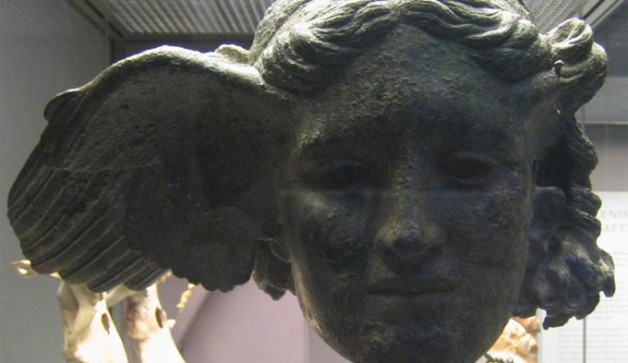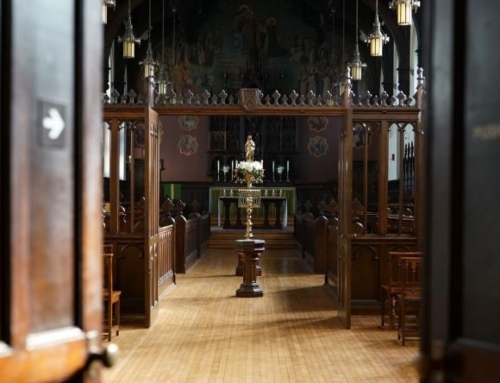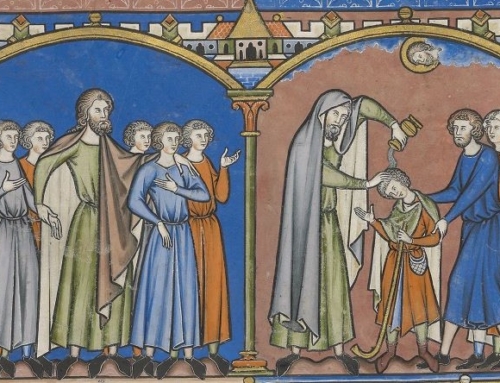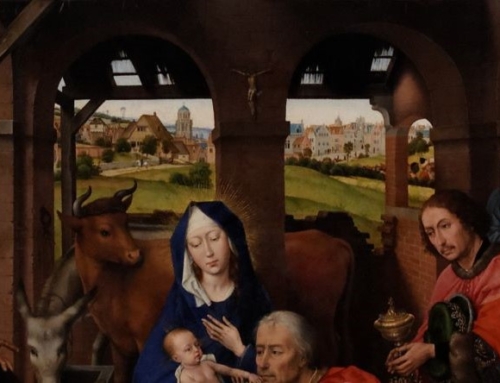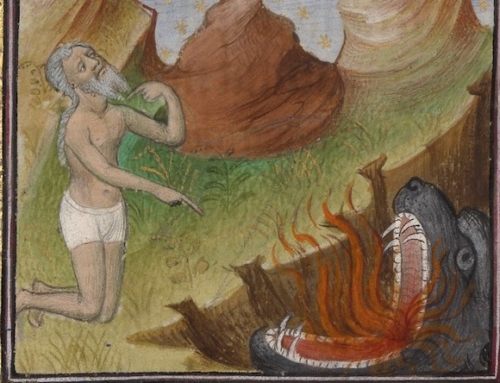Then I saw another angel come up from the East, holding the seal of the living God. He cried out in a loud voice to the four angels who were given power to damage the land and the sea, “Do not damage the land or the sea or the trees until we put the seal on the foreheads of the servants of our God.”
—Revelation 7:2-3Then I saw another beast come up out of the earth; it had two horns like a lamb’s but spoke like a dragon… It forced all the people, small and great, rich and poor, free and slave, to be given a stamped image on their right hands or their foreheads, so that no one could buy or sell except one who had the stamped image of the beast’s name or the number that stood for its name.
—Revelation 13:11, 16-17The spirit lifted me up between earth and heaven and brought me in divine vision to Jerusalem… Then the glory of the God of Israel moved off the cherub and went up to the threshold of the temple. He called to the man dressed in linen with the scribe’s case at his waist, and the LORD said to him: Pass through the city, through the midst of Jerusalem, and mark an X on the foreheads of those who grieve and lament over all the abominations practiced within it. To the others he said in my hearing: Pass through the city after him and strike! Do not let your eyes spare; do not take pity. Old and young, male and female, women and children—wipe them out! But do not touch anyone marked with the X. Begin at my sanctuary. So they began with the elders who were in front of the temple.
—Ezekiel 8:3, 9:3-6
Another very famous set of images from the Book of Revelation is the Seal of God and the demonic parody of it, the Mark of the Beast.
Many people who have read the Book of Revelation are on the lookout for a bodily mark or some modification of the body that would constitute the “Mark of the Beast;” once I even saw a pamphlet arguing that EZ-Pass is that baneful brand. But is the Book of Revelation primarily warning us about the condition of our bodies, or the condition of our souls?
We saw by comparison with the Book of Daniel that the visions of beasts in the Book of Revelation are not warning us to stay away from dangerous animals that can harm the body but do nothing to the soul. Those who are wise and instructed in the Scriptures see that it is warning us about the true danger of wicked rulers who do the will of the devil.
Similarly, we can see that God claiming his own by marking their foreheads (and by extension the devil’s parody of this) is an adaptation of the image from Ezekiel’s prophetic vision quoted above.
But in the Book of Ezekiel, did the forehead mark in Ezekiel’s vision correspond to a bodily mark that was visible in everyday life outside the vision, or did it signify something else? Reading Ezekiel shows that the latter is definitely the case. The mark of God on the forehead of the innocent was something that only Ezekiel and the angels could see, and Ezekiel could only see it in his vision. Outside the vision, it didn’t look like a bodily mark at all. It looked like some people staying faithful to God in their hearts and in their actions, lamenting the evils that others did, while others were forsaking God by committing wicked acts and participating in false religious rites.
Therefore when we read in the Book of Revelation a prophetic vision involving marks on the forehead in a way that clearly invokes Ezekiel’s vision, we should expect that Revelation, like Ezekiel, is showing us invisible, spiritual realities by means of visible symbols. By reasoning from Ezekiel, we should expect that the Marks of God and of the Beast in Revelation correspond to faithfulness to God and his worship and perseverance in wickedness and false religion respectively.
Although some may find this surprising, it is not at all an innovation in Christian interpretation of the Book of Revelation. St. Thomas Aquinas comes to just the same conclusion in his Summa Theologiae, where he says “The ‘character [mark] of the beast’ may be understood to mean either the obstinate malice for which some are assigned to eternal punishment, or the profession of an unlawful form of worship.”
The devil doesn’t care about the state of your skin—he cares about the state of your soul, to ruin it. What he really wants is to get you out of the Catholic Church and into error and sin and have you stay there obstinately.
Those who remain on the surface of the Book of Revelation and are thus unable to enter into its mysteries and receive its true message tend to interpret St. John’s visions as if they were primarily about bodily dangers, like a physical Mark of the Beast, or avoiding bodily evils, like suffering. This is a perennial temptation, as we see in the popularity now of the so-called “prosperity Gospel.” But it is just the opposite of what Jesus tells us in the Gospels. “Take up your cross and follow me,” says the Savior, and “do not fear those who can kill the body.”
Certainly it matters what we do with our bodies, since a human being is a unity of body and soul, and therefore we can sin by our actions done with the body. But the Book of Revelation is not primarily about bodily goods—instead, it points us toward the higher spiritual truths it reveals through visible signs in prophetic visions.
Image: Statue of Hypnos

